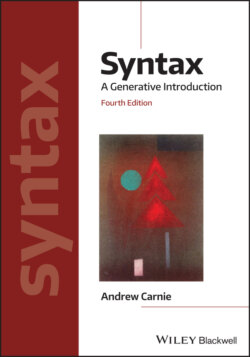Читать книгу Syntax - Andrew Carnie - Страница 14
Do Abstract Rules Really Exist?
ОглавлениеAs discussed in detail later in this chapter, the approach to grammar we are using here is supposed to be part cognitive psychology, so it’s reasonable to ask whether formal rules really exist in the brain/minds of speakers. After all, a brain is a mass of neurons firing away, so how can abstract rules exist up there? Remember, however, that we are attempting to model language; we aren’t trying to describe language exactly. This question confuses two disciplines: psychology and neurology. Psychology is concerned with the mind, which represents the output and the abstract organization of the brain.
Neurology is concerned with the actual firing of the neurons and the physiology of the brain. Our approach doesn’t try to be a theory of neurology. Instead it is a model of the psychology of language. Obviously, the rules per se don’t exist in our brains, but they do model the external behavior of the mind. For more discussion of this issue, look at the readings in the further reading section of this chapter.
3.1 An Example of the Scientific Method as Applied to Syntax
Let’s turn now to a real-world application of the scientific method to some language data. The following data concern the form of a specific kind of noun, called an anaphor (plural: anaphors; the phenomenon is called anaphora). These include the nouns that end with - self (e.g., himself, herself, itself). In chapter 5, we look at the distribution of anaphors in detail; here we’ll only consider one superficial aspect of them. In the following sentences, as is standard in the syntactic literature, a sentence that isn’t well-formed is marked with an asterisk (*) before it. For these sentences assume that Bill is male and Sally is female.
2)
1 Bill kissed himself.
2 *Bill kissed herself.
3 Sally kissed herself.
4 *Sally kissed himself.
5 *Kiss himself.
Under the assumption that Bill is a cisgender male and Sally is a cisgender female, the ill- formed sentences in (2b and d) just look silly. It is obvious that Bill can’t kiss herself, because Bill is male. There is a clear generalization about the distribution of anaphors here. In particular, the generalization we can draw about the sentences in (2) is that an anaphor must agree in grammatical gender with the noun it refers to (its antecedent). So. in (2a & b) we see that the anaphor must agree in gender with Bill, its antecedent. The anaphor must take the masculine form himself. The situation in (2c & d) is the same; the anaphor must take the form herself so that it agrees in gender with the feminine Sally. Note further that a sentence like (2e) shows us that anaphors must have an antecedent. An anaphor without an antecedent is unacceptable. A plausible hypothesis (or rule) given the data in (2), then, is stated in (3):
3) An anaphor must (i) have an antecedent and (ii) agree in grammatical gender (masculine, feminine, or neuter) with that antecedent.
The next step in the scientific method is to test this hypothesis against more data. Consider the additional data in (4):
4)
1 The robot kissed itself.
2 She knocked herself on the head with a zucchini.
3 *She knocked himself on the head with a zucchini.
4 The snake flattened itself against the rock.
5 ?The snake flattened himself/herself against the rock.
6 The Joneses think themselves the best family on the block.
7 *The Joneses think himself the wealthiest guy on the block.
8 Gary and Kevin ran themselves into exhaustion.
9 *Gary and Kevin ran himself into exhaustion.
